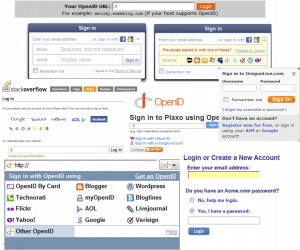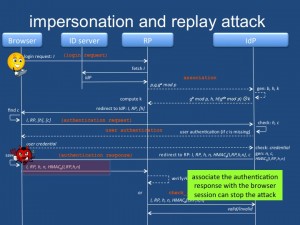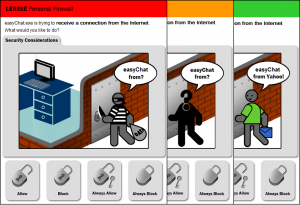There is evidence that the communication of security risks to home computer users has been unsuccessful. Prior research has found that users do not heed risk communications, that they do not read security warning texts, and that they ignore them. Risk communication should convey the basic facts relevant to the warning recipient’s decision. In the warning science literature, one successful technique for characterizing and designing risk communication is to employ the mental models approach, which is a decision-analytic framework. With this approach, the design of risk communication is based on the recipients’ mental model(s). The goal of the framework is to help people make decisions by providing risk communication that improves the recipients’ mental models in one of three ways: (1) adding missing knowledge, (2) restructuring the person’s knowledge when it inappropriately focussed (i.e., too general or too narrow), and (3) removing misconceptions.
Category Archives: human factos in security
Heuristics for Evaluating IT Security Management Tools
 The usability of IT security management (ITSM) tools is hard to evaluate by regular methods, making heuristic evaluation attractive. However, standard usability heuristics (e.g., Nielsen’s) are hard to apply, as IT security management occurs within a complex and collaborative context that involves diverse stakeholders. In a joint project with CA Technologies, my Ph.D. student Pooya Jaferian has proposed a set of ITSM usability heuristics that are based on activity theory, are supported by prior research, and consider the complex and cooperative nature of security management. The paper reporting the evaluation of the heuristics received Best Paper Award at SOUPS ’11.
The usability of IT security management (ITSM) tools is hard to evaluate by regular methods, making heuristic evaluation attractive. However, standard usability heuristics (e.g., Nielsen’s) are hard to apply, as IT security management occurs within a complex and collaborative context that involves diverse stakeholders. In a joint project with CA Technologies, my Ph.D. student Pooya Jaferian has proposed a set of ITSM usability heuristics that are based on activity theory, are supported by prior research, and consider the complex and cooperative nature of security management. The paper reporting the evaluation of the heuristics received Best Paper Award at SOUPS ’11.
Have users signed up?
 I participated in a panel “Password Managers, Single Sign-On, Federated ID: Have users signed up?” at Workshop on The Future of User Authentication and Authorization on the Web: Challenges in Current Practice, New Threats, and Research Directions, which was collocated with the conference on Financial Cryptography and Data Security. In my panel presentation, I showed the most recent results of the evaluation of OpenID authentication experience by participants, conducted in my lab, which shed some light on why users have not signed up, at least for OpenID. An apparent reluctance among the end users of employing OpenID, despite the fact that there are over one billion OpenId-enabled accounts, results from technical, business, and human factors. This particular short presentation was devoted to the usability factors.
I participated in a panel “Password Managers, Single Sign-On, Federated ID: Have users signed up?” at Workshop on The Future of User Authentication and Authorization on the Web: Challenges in Current Practice, New Threats, and Research Directions, which was collocated with the conference on Financial Cryptography and Data Security. In my panel presentation, I showed the most recent results of the evaluation of OpenID authentication experience by participants, conducted in my lab, which shed some light on why users have not signed up, at least for OpenID. An apparent reluctance among the end users of employing OpenID, despite the fact that there are over one billion OpenId-enabled accounts, results from technical, business, and human factors. This particular short presentation was devoted to the usability factors.
Is OpenID too Open? Technical, Business, and Human Issues That Get in the Way of OpenID and Ways of Addressing Them
 The web is essential for business and personal activities well beyond information retrieval, such online banking, financial transactions, and payment authorization, but reliable user authentication remains a challenge. OpenID is a mainstream Web single sign-on (SSO) solution intended for Internet-scale adoption. There are currently over one billion OpenID-enabled user accounts provided by major content-hosting and service providers (CSPs), e.g., Yahoo!, Google, Facebook, but only a few relying parties that allow users to use their OpenID credentials for SSO. Why is that? I presented at Eurecom an overview OpenID, and then discussed weaknesses of (1) the protocol and its implementations, (2) the business model behind it, and (3) the user interface. The talk concluded with a discussion of a proposal for addressing some of OpenID issues.
The web is essential for business and personal activities well beyond information retrieval, such online banking, financial transactions, and payment authorization, but reliable user authentication remains a challenge. OpenID is a mainstream Web single sign-on (SSO) solution intended for Internet-scale adoption. There are currently over one billion OpenID-enabled user accounts provided by major content-hosting and service providers (CSPs), e.g., Yahoo!, Google, Facebook, but only a few relying parties that allow users to use their OpenID credentials for SSO. Why is that? I presented at Eurecom an overview OpenID, and then discussed weaknesses of (1) the protocol and its implementations, (2) the business model behind it, and (3) the user interface. The talk concluded with a discussion of a proposal for addressing some of OpenID issues.
See presentation slides for more details.
Undergrad Security Course Features Cool Projects
Students in my undergraduate computer security course had done several excellent projects. You can watch video clips of the projects or read reports.

